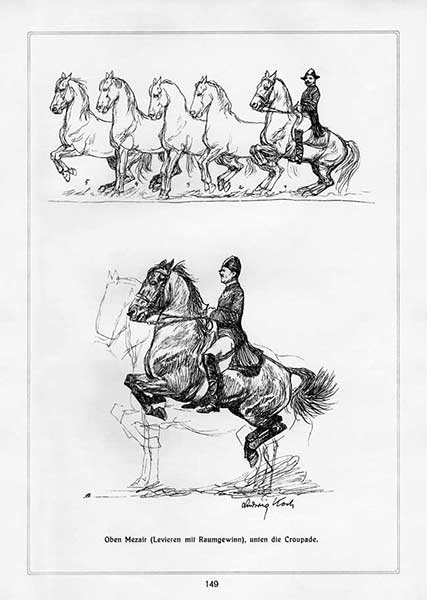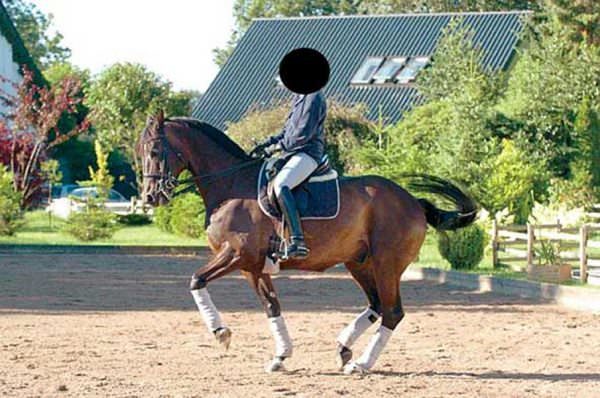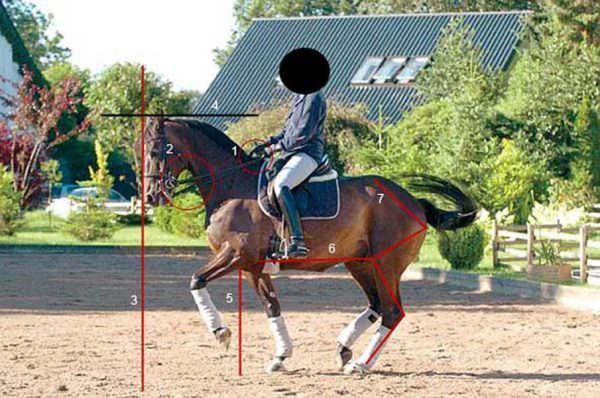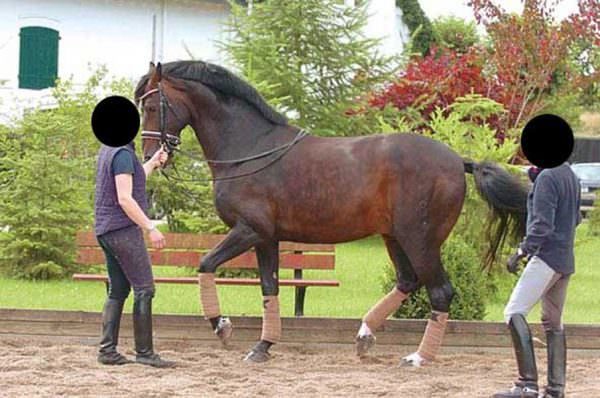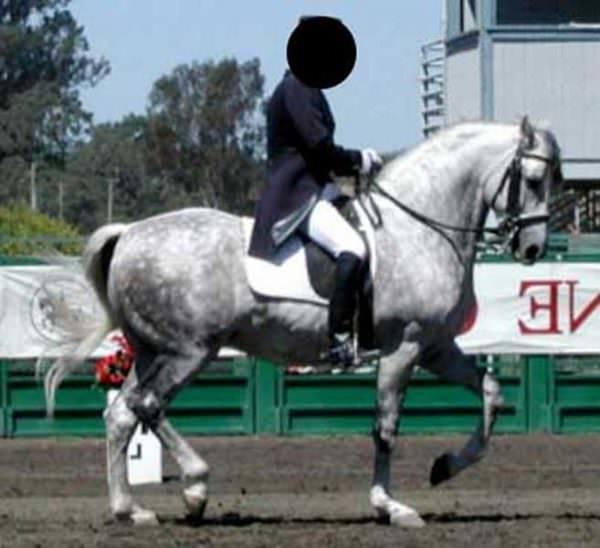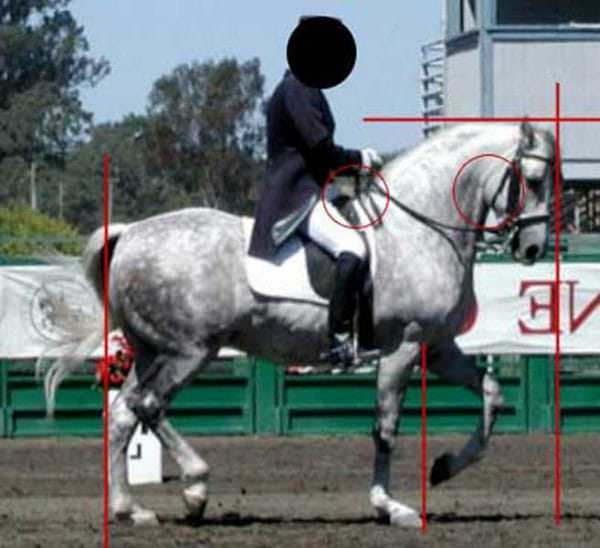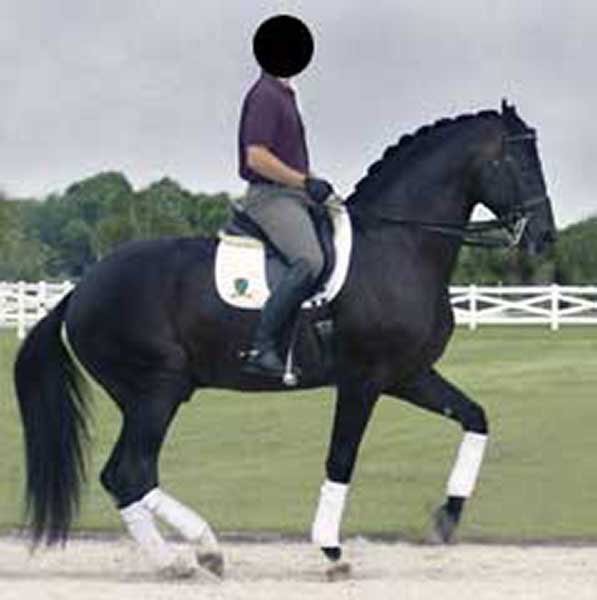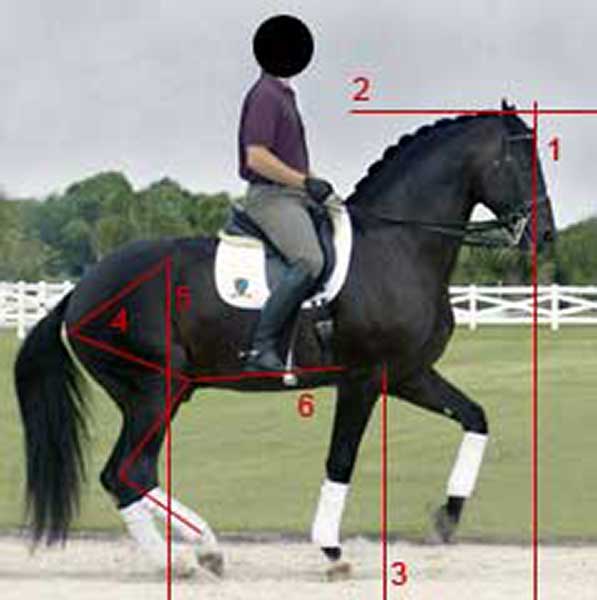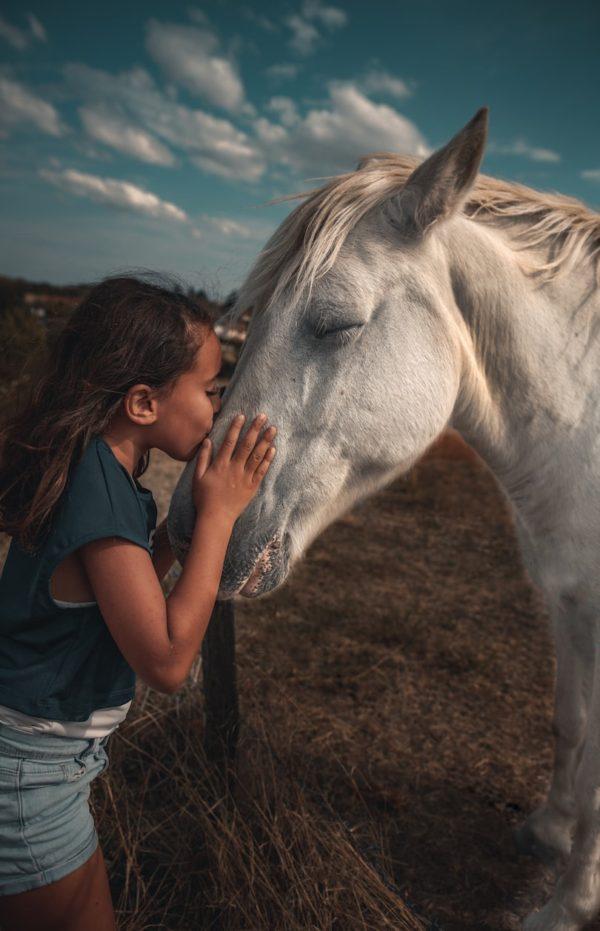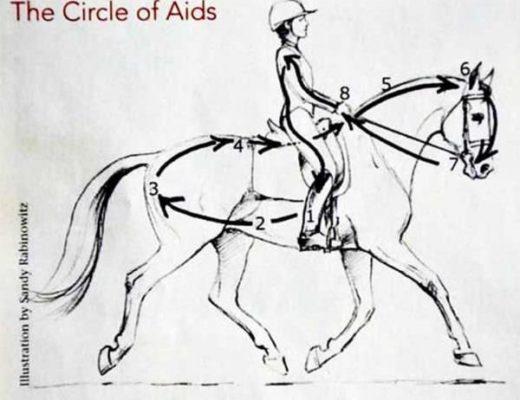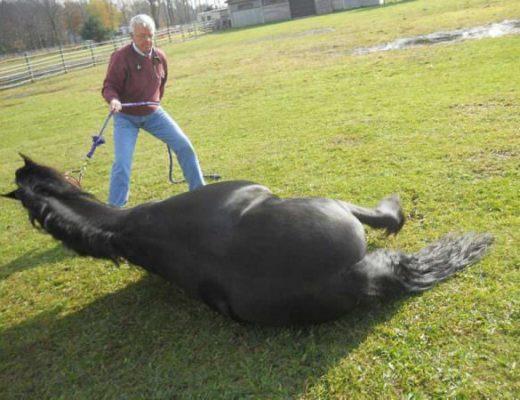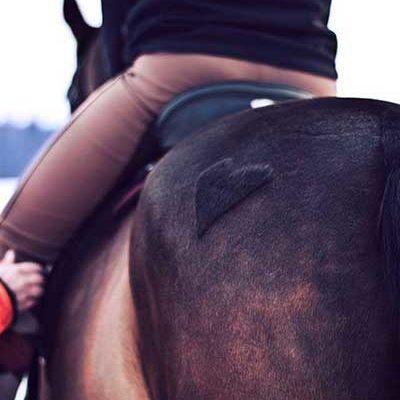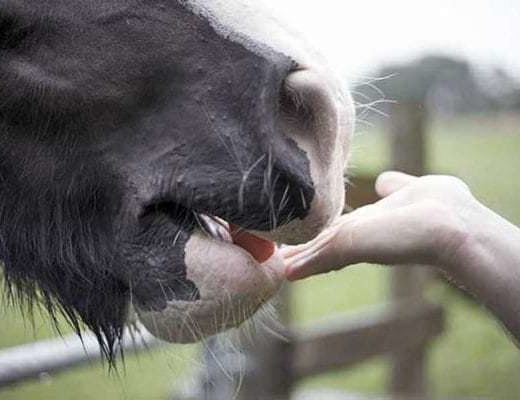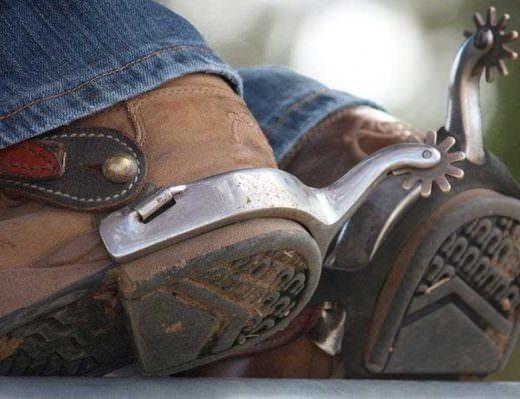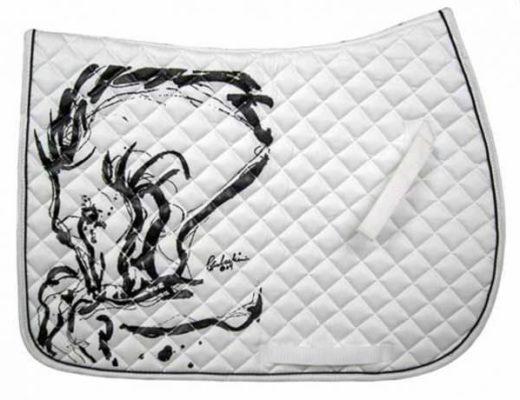It isn't because I love picking on competitive Dressage, it is because it is prevalent in competitive Dressage since it is right in front of us, that I can point to the examples so easily seen. False forms of collection abound in every arena however, and it isn't because it is more fun to fake it, but often because we don't know what to look for, how to recognize when that fun movement isn't really what we thought it was, and not sure how else to train the horse.
I work a lot in metaphors, it helps my mind connect ideas and make sense of theories that may otherwise leave me in the dark. So, this is how I'm going to compare collection in the sense of competitive dressage… a bit like a weight lifter bench pressing weights that are inflated with air. Sure, it might look like he is lifting 300 pounds and his muscles are certainly flexed, he has some sweat upon his brow… but there is something missing and that is the reality of the weight, the action, the exercise. It looks like a bench press and acts like a bench press, but is he really lifting any weight? No.
What we see in the competitive arena are collected movements that look like collection, act like collection, are called collection and scored as though they are collection, but there is that vital thing missing – the reality of collection.
Let's think a bit about the individual movements that are a result of collection : Piaffe, Passage, Canter Pirouette, Flying Changes, Collected Canter, Collected Walk, Extended Trot. Collection unfortunately is often mistaken as being synonymous with slow or short. We see many variations on these different movements and instead of writing a giant article, I think instead I will pull a collection of pictures together and make comments. I like the way my brain functions with visual interaction…
The Piaffe
Let's start with something easy. Why do I say easy? Well because there are many more pictures of piaffe that I can track down than there are collected walk.
Ever notice that there is a large prevalence of stallions in the competitive arena of dressage who succeed vs geldings and mares at the international levels. Certainly, it is beneficial to promote breeding stallions, but it occurred to me a question of whether it has anything to do with the strength of their neck muscles, in particular those which help to lift the shoulder girdle. Testosterone does lead to more muscle mass and development, and stallions naturally have a greater development of their topline. It can certainly help mask one of the indicators of collection, and that is the ‘little dipper' in front of the withers. Many stallions are without it thanks to mother nature. So how does this play a role in collection you ask?
The neck muscles assist in lifting the cervical vertebrae as well as the shoulder girdle. Changing this alignment assists the hindquarters in bearing weight and flexing of the joints… all important elements of collection. In many ways, the efforts of asking the horse to collect are a way of improving the horse's posture. Just like humans, we don't always have naturally good posture, and when we then lift things and become weight bearing we can damage our muscles, our joints, our bones, etc. Things wear and tear that aren't supposed to. What happens when you pick up something with bad posture? Do you find that you are nimble, agile and able to move easily about with this new weight, or do you tend to feel the weight pressing down upon you, having difficulty moving up and down stairs with this weight, maneuvering tight areas and so on? Then try lifting an object and carrying it with good posture so you are in balance, that is exactly the purpose of collection, and the movements listed above that come about are only signs and signals of that achieved balance while bearing weight.
Okay, I'm getting a bit off direction, but that is okay. I wanted to touch on the matter of hock injections in dressage horses who have not yet hit the age of 10. Sound like they are wearing their joints improperly? Absolutely! That is a sign of weight bearing that is not in balance, and is not in collection! It is one thing in a sport of impact such as jumping and eventing, but riding your pony about a 20 x 60 meter, imo, should not warrant hock injections at an early age. Back on track…
Now, before you go scrolling down and getting adventuresome on me… let's talk about the first picture. Yes, I will be blacking out faces because I would hope someone would do the same for me and this isn't some personal vendetta against competitive riding, my only goal is to pull attention to what to look for in clues whether your horse is giving you collection.
I want you to look the picture over, maybe even write down what you like and what you don't like. Let's do this with 5 things each, 5 likes and 5 dislikes. We'll compare notes later. Often piaffe is considered correct when the horse brings the hind feet underneath the body, i.e. underneath the point of hip, when the diagonal legs are moving in unison, and the horse's head is on the vertical. Now we've already covered some points referring to posture, but I want to reiterate. In particular with the position of the horse's head. Not all horses are posturally capable of bringing their nose on the vertical and still maintaining the posture needed to be balanced in collection. Often what happens is that the horse compensates in his body somewhere for the position of the head that he is otherwise not physically capable of maintaining.
Humans do this sort of postural compensation all the time. It is prevalent among our species and you can see it in person just walking down the street on any given day… that is if you know what you are looking for. If you don't, people just look like people, normal everyday people. In this case it is usually only those who overstep the boundaries by a large margin that we notice – someone hunched over with a humpback posture, or someone with such an extreme swayback that it obviously affects their walking pattern. The person who's neck juts forwards, or the man who doesn't seem to have any bend in his neck at all.
For the most part, we all have postural problems, and unfortunately it is considered a norm. The things that cause chronic but not completely debilitating low back pain, the migraine headaches that we put up with or try to sooth with medication and dark rooms. The list goes on. With the horse we invent new gadgets to deal with the postural problems, we use more force and leverage to ‘stretch' and ‘flex' him into “suppleness.” Then there are the new methods of training that are ‘based upon classical principles' and only prove to further injure the horse on a whole new level.
Let's see how this horse might be compensating for posture that isn't bringing him into balance.
I hope you like the marks I made, it will help guide your sight to the what and where's that I talk about. Firstly, what I mentioned earlier about the development of the neck muscles and the tell-tale dip in front of the withers. That is marked with a red circle and labelled with a 1. It isn't the best quality picture, but it is fairly clear to see.
Next we will move on to spot 2, the second red circle. This is referencing the closure of the horse's throatlatch. Again, not all horses are capable of maintaining an ‘on the vertical' nose position without having to compensate somewhere in their body. Line 3 references this as well, showing the nose on the vertical. Line 4 references the poll being the highest part of the horse's body. His is close, but no cigar, the crest of his neck beat him to it by a few hairs. Why is the poll being high an important indicator? With the exception of some stallions (particularly Spanish bred) whose necks are so cresty they would not in a million years make the mark, it shows that the horse is not compensating in the cervical vertebrae. When the horse is overbent, or made to come to the vertical without the right build for it, his cervical vertebrae will help compensate and as a result the posterior portion of the neck (the top of the neck) will protrude higher than the poll. Think of a piece of paper, held so you are looking at the flattest/thinnest portion, held between your thumb and forefinger on either end. When you hold the paper taught so that it is straight, it is structurally at it's strongest (if paper can be strong…) without having to be modified. You can lift one end and lower the other and it stays the same strength. Now, you are going to hold one end (this will be considered the horse's withers) just as before, the other end (which is now the horse's forehead), you are going to make a fold about an inch from the edge as though the new ‘tab' is the front of the horse's face. Make it in such a way that it is about a 45 degree angle difference from it's original position in a straight line. Resume holding the tab with your thumb and forefinger, now bring the horse's nose to a vertical position. What happens along the horse's neck? Does the crest bow upwards behind the horse's poll making it the highest point? And what about near the withers? Does it create a hollow there as well? This is why the common use of bringing the horse's nose on the vertical is not a sign of collection, but often a sign of postural compensation.
Let's get rid of the paper. The next point is line 5 – which shows a vertical alignment for the weight-bearing front leg. Notice that the leg does not align vertically? What this shows is that the horse's posture has to compensate in some manner for weight bearing the hind legs. The horse is bringing the front leg behind and under him to assist in bearing weight vs flexing the joints of the hindquarters, adjusting the relationship of the cervical vertebrae and the shoulder girdle and finding balance in collection. So the front legs are still bearing a large amount of weight that the hind legs are not capable of doing in this postural arrangement.
Line 6 is just a basic reference for your mind. The relationship between the point of shoulder and the stifle, points to the fact that the horse's hindquarters are not actually ‘sitting' anymore than the joints are flexing.
And finally, the lines of 7. These show the reference angles between the joints in the horse's hindquarters. The angle between the stifle, hock and fetlock shows it to be very open, bracing almost. The foot is well under the horse's body but the lack of flexion shows that the horse isn't balanced and isn't collected.
In Case you are wondering about the ‘naked development' of the horse, i.e. the horse's physical development in piaffe without a saddle and rider… here's a link to the same horse performing piaffe in hand. Note the same dip in front of the withers, nose on the vertical creating the highest point of the neck to be behind the poll. Lack of engagement in the hind legs…
Next Up : Another Piaffe
So again, as before, 5 likes and 5 dislikes. This is a good contrasting piaffe because these are two very differently bred horses, and two different kinds of compensation.
Now, onto the next example, I hope you haven't been peeking…
Once again I have laid out lines to make it easier to understand. I managed to forget numbering them however… so bear with me.
We'll start from right to left, first with the vertical line, showing the horse is actually behind the vertical with his nose. The horizontal line again demonstrates that his poll is not the highest point, by a greater measure than our first example. The circle around his throatlatch shows that it is closed. Second circle near the withers points out that although the horse has a very well developed crest, there is still a mild dip near the withers.
The vertical line on the weight bearing foreleg shows that he is not compensating nearly as much to support the weight bearing of the hind legs by dropping his front leg underneath himself, but if we then turn our attention to the hind limb that is weight bearing we can see that he is not on the hindquarters at all as it trails out almost behind his body in the weight bearing phase.
I like to think of it like this a little… what happens when we mess around with our posture. Take your head and bring your chin in as far as it will go, if you can touch your chest great, if not that is fine. Take it to the limit that you can structurally go. Now, hold this posture while you are sitting first. Maybe even sit beside a full length mirror. Pay attention to what happens to your shoulders. Do they round forward over time? Try to hold your posture perfectly straight while you keep your chin in position. You may be capable initially, but over time your muscles become tired and your body tries to compensate for this awkward and unnatural position.
Now, do the same exercise while standing. Pay close attention to what happens to your hips. Do they rotate forwards or back? Are you able to flatten your low back and take the curve out of it? That is in effect much of what the horse has to do in the piaffe when correctly collected, he utilizes the strength of his loin while changing the angle of his pelvis. In humans it would be taking the curve out of the low back, flexing our leg joints. How is your body feeling with your head in this position? It would be really easy for someone to influence your speed and direction if you kept your head in this position, it affects your posture and weakens your balance point.
Piaffe 3
By now, you should know the drill.. 5 likes and 5 dislikes.
I just want to point out ahead of time, that of the three examples, this is the only image which displays a horse whose tail isn't swishing and muscles overall appear generally soft and supple. Just a side note.
Now, onto my marked up image, and I even remembered numbers! Yay…
I have failed to add the circles around the throatlatch and at the withers on this image, for two reasons. First, the throatlatch is open and I think that is pretty clear to see. Second, the withers are not really clear to see beyond the saddle pad, so will receive little commenting from me, I try not to make assumptions when possible.
Line #1, shows the horse's nose beyond the vertical, allowing his throatlatch to stay open, him to effectively use his neck muscles in lifting the shoulder girdle and adjusting his overall posture to change weightbearing to the hindquarters. Line #2 demonstrates the poll as the highest point.
Line #3 shows the one vital place of weakness, that being that the front leg is stepping underneath the horse to help bear weight. Based upon the overall picture of this piaffe I could try to surmise that it may be some form of muscular weakness that he has not yet been developed physically enough to maintain this correct posture without some help from the front end yet. That being said, it is still only a guess and will lead into nothing more.
Lines #4 show more flexion in the hind limb joints. They are closing more, think of how an accordion folds into itself. The angles between the lines are also fairly even which shows that the joints are bearing stress fairly equally.
Line #5 is a reference showing the relative position between the weight bearing foot and the horse's point of hip. The hip is beginning to be the primary point of stress overall, vs the fetlock, hock or stifle joint. If the horse were to come underneath himself anymore the loins would take the brunt of the load.
Line #6 is again one more reference showing that the hindquarters are indeed dropping rather than maintaining level with the horse's front end.
